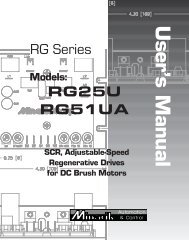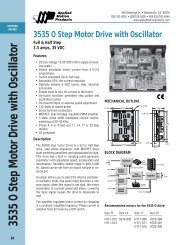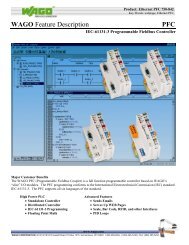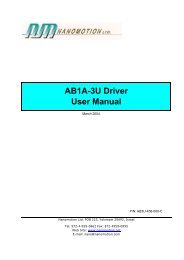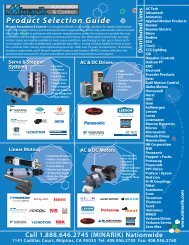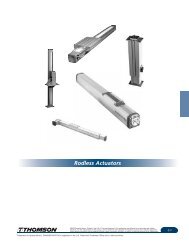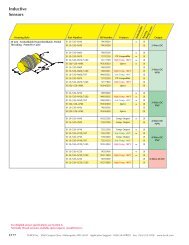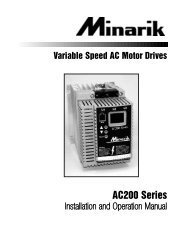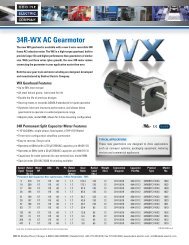Improving Servo System Design to Optimize Coating ... - Kollmorgen
Improving Servo System Design to Optimize Coating ... - Kollmorgen
Improving Servo System Design to Optimize Coating ... - Kollmorgen
You also want an ePaper? Increase the reach of your titles
YUMPU automatically turns print PDFs into web optimized ePapers that Google loves.
IMPROVING SERVO SYSTEM DESIGN TO OPTIMIZE COATING AND LAMINATING QUALITY<strong>Improving</strong> <strong>Servo</strong> <strong>System</strong><strong>Design</strong> <strong>to</strong> <strong>Optimize</strong> <strong>Coating</strong>and Laminating Quality1Tom England, Market Development Direc<strong>to</strong>r
IMPROVING SERVO SYSTEM DESIGN TO OPTIMIZE COATING AND LAMINATING QUALITYIn some cases these concerns can be adequatelyaddressed by selecting high-quality mechanicaltransmission components. However, the added expensecan become prohibitive and they will still weareventually. The ultimate solution is a direct drive rotarysystem, which eliminates the transmission al<strong>to</strong>gether. Indirect drive systems, the mo<strong>to</strong>r directly drives the load.The accuracy of direct drive systems can be up <strong>to</strong> 60times better than that of traditional systems and audiblenoise can fall by 20 dB. Other measures such as servoresponse (bandwidth), machine parts reduction, andreliability also can improve dramatically.The mo<strong>to</strong>r's primary contribution <strong>to</strong> velocity ripple is itselectromagnetic cogging, which is usually at the pole orslot frequency or some multiple of it. The best way <strong>to</strong>overcome electromagnetic cogging is <strong>to</strong> begin with a lowcogging mo<strong>to</strong>r that requires less correction. Highperformancemo<strong>to</strong>rs with less than 1% pk-pk coggingare a very good start, and nearly always superiorcompared with standard mo<strong>to</strong>r options due <strong>to</strong> betterelectromagnetic design, and simulation of theelectromagnetic circuit.Frameless Direct Drive Mo<strong>to</strong>rsWhen the load is directly coupled, there is no limitationon the inertia mismatch between load and mo<strong>to</strong>r. Theservo loop gains can now be increased significantly <strong>to</strong>provide the necessary servo stiffness <strong>to</strong> achieveexcellent speed regulation <strong>to</strong> optimize product quality.Web speeds can be increased in many applicationsusing direct drive technology because the accuracy ofthe mechanical transmission system is often the limitingfac<strong>to</strong>r.When the transmission components such as gearboxes,belts, rack and pinion, and pulleys are eliminated, theservo system becomes free of such negative fac<strong>to</strong>rs ascompliance, backlash, and component wear. Theaccuracy increases, inertia-matching requirements relax,acceleration and deceleration improve, maintenancebecomes unnecessary, and the product life increases bya significant degree.Direct drive rotary mo<strong>to</strong>r size can be based on the peak<strong>to</strong>rque required for achieving the desired accelerationtime specifications. With direct drives, inertia mismatchof 250 <strong>to</strong> 1 is common and mismatch of 800 <strong>to</strong> 1 hasbeen implemented. In many coating and laminatingapplications, the size of the mo<strong>to</strong>r is dictated by theinertial matching requirements. The result is that a muchsmaller and more energy-efficient DDR mo<strong>to</strong>r can beused in most applications.<strong>Kollmorgen</strong>’s KBM series frameless brushless mo<strong>to</strong>rsDirect drive rotary technology has developed in anevolutionary manner. The original frameless direct drivemo<strong>to</strong>rs were designed in<strong>to</strong> the machine architecturealong with a feedback device and became a fullyintegrated part of the machine. This approach has theadvantage of consuming the least amount of space. Onthe other hand, frameless mo<strong>to</strong>rs are relativelyexpensive <strong>to</strong> fully integrate as they typically requiresubstantial changes <strong>to</strong> the design of the underlyingmachine. Frameless mo<strong>to</strong>rs are also more difficult <strong>to</strong>service because they are embedded in<strong>to</strong> the machine.While the initial development cost burden is high, thebenefits of higher performance, higher quality, and smallspace requirements justify this technology in someapplications.Full Frame <strong>System</strong>s<strong>Kollmorgen</strong>’s Housed DDR mo<strong>to</strong>rsDDR mo<strong>to</strong>rs deliver increased throughputThe next generation of direct drive rotary technology,sometimes referred <strong>to</strong> as full frame systems, integratesall of the components of a complete mo<strong>to</strong>r including the3
IMPROVING SERVO SYSTEM DESIGN TO OPTIMIZE COATING AND LAMINATING QUALITYro<strong>to</strong>r, sta<strong>to</strong>r, bearings and feedback device within ahousing. The machine shaft slips through the bore in themo<strong>to</strong>r and attaches <strong>to</strong> the ro<strong>to</strong>r. This approachsubstantially reduces development costs since the mo<strong>to</strong>rno longer needs <strong>to</strong> be integrated with the coating roll.The disadvantage of this approach is that the mo<strong>to</strong>r andmachine bearings must be precisely aligned, which is acomplex and time-consuming task. The bearings in themo<strong>to</strong>r and the load are directly coupled in a linearfashion making it nearly impossible <strong>to</strong> align the systemcomponents properly without causing premature bearingfailure due <strong>to</strong> uneven loading.Installation typically takes less than five minutes. Themo<strong>to</strong>r slides over the shaft until a mo<strong>to</strong>r pilot engages amachine pilot. The housing is secured with bolts. Themo<strong>to</strong>r ro<strong>to</strong>r is then secured <strong>to</strong> the machine roller shaft bymeans of a compression coupling tightened <strong>to</strong> aspecified <strong>to</strong>rque. The ro<strong>to</strong>r is now rigidly connected <strong>to</strong>the machine shaft. The encoder alignment is pre-set sothat no adjustments need <strong>to</strong> be made. Cables areconnected and the mo<strong>to</strong>r is ready <strong>to</strong> run.<strong>Kollmorgen</strong> Cartridge DDR® mo<strong>to</strong>rs<strong>Kollmorgen</strong> Cartridge DDR® mo<strong>to</strong>rsThe most recent approach <strong>to</strong> DDR systems is the<strong>Kollmorgen</strong> Cartridge DDR mo<strong>to</strong>r which is fully housedand ready for mounting <strong>to</strong> the machine. However it hasno bearings in the mo<strong>to</strong>r, but instead uses the hostmachine <strong>to</strong> support the mo<strong>to</strong>r’s ro<strong>to</strong>r. This approachmakes it easy <strong>to</strong> use direct drive technology onmachinery that already has bearings, particularly inapplications such as coating, laminating and printingwhere rollers already use heavy-duty, precisionbearings. The mo<strong>to</strong>r has a hole in the middle which slipsover the shaft extension of the roll and the mo<strong>to</strong>rhousing bolts <strong>to</strong> the machine frame.Proprietary electromagnetic design gives<strong>Kollmorgen</strong> Cartridge DDR® mo<strong>to</strong>rs more <strong>to</strong>rque per volumethan conventional DDR technology.A servo system equipped with a <strong>Kollmorgen</strong> CartridgeDDR servomo<strong>to</strong>r is expected <strong>to</strong> work for ten yearswithout any maintenance. Although the initial systemcost might be higher compared <strong>to</strong> a conventional gearedsystem, over a period of several years, eliminating thecost of repairs and periodic maintenance makes theoverall cost of purchasing and operating a cartridgesystem lower. Even with the slightly higher initial cost,over a five-year period, <strong>Kollmorgen</strong> Cartridge DDRmo<strong>to</strong>rs can reduce operating costs up <strong>to</strong> $10,000 permotion axis compared <strong>to</strong> conventional geared servosystems.Press-feed machine builtwith a conventionalservomo<strong>to</strong>r, gearhead, beltand pulleys.4
IMPROVING SERVO SYSTEM DESIGN TO OPTIMIZE COATING AND LAMINATING QUALITY<strong>Improving</strong> Feedback Device PerformanceSince the feedback device is in the control loop, anyerror of the device itself is "corrected" by the drive in theservo loop, and ends up as a velocity ripple on thecoating roll. As the servo loop gain is increased theerror in the feedback device is amplified and transferredin<strong>to</strong> the coating roll. So, starting with as precise afeedback device as possible is very important <strong>to</strong>minimize velocity ripple. There are several ways thataccuracy can be improved. The most straightforward is<strong>to</strong> use a more accurate device. For example, mostencoder manufacturers offer encoders in a variety ofresolutions. Resolution is usually measured in lines perrevolution. Encoders with higher line counts usuallyhave greater accuracy. However, this is not always thecase, so users must check the specifications of theencoder carefully. In some cases, highly resolveddevices can still be relatively inaccurate.Users can also change the type of feedback device.Sine encoders are the most accurate mo<strong>to</strong>r-mountedfeedback devices commonly used in industrial servosystems. Sine encoders are typically accurate <strong>to</strong> +/-25arc-sec, compared with a resolver at +/- 10 arc-min.High-line-count incremental encoders (above 10,000lines-per-revolution) are also often highly accurate.Medium line-count encoders (2,000 <strong>to</strong> 10,000 lines-perrevolution)are fairly accurate, usually holding 3 arcminutesor less. Resolvers are the least accuratesensors, typically holding from 5 <strong>to</strong> 20 arc minutes.Effect of the <strong>Servo</strong> DriveSame machine with a<strong>Kollmorgen</strong> Cartridge DDR®mo<strong>to</strong>r installed.Here, the shaft of the driven rollis extended in<strong>to</strong> the CartridgeDDR mo<strong>to</strong>r and the mo<strong>to</strong>rapplies <strong>to</strong>rque directly <strong>to</strong> thedriven roll.The servo drive such as <strong>Kollmorgen</strong>’s AKD® can add <strong>to</strong>and correct various velocity ripple components. It adds<strong>to</strong> the ripple by having uneven current loop gains in eachof the phases, i.e. phase A might be 1% higher thanphase B or C and this causes a <strong>to</strong>rque error in themo<strong>to</strong>r. Likewise, the amplitudes of each phase might beslightly different adding an error <strong>to</strong> the <strong>to</strong>rque as well.The drive can correct these by having digitaladjustments in the current loops <strong>to</strong> take out these offseterrors.One can also reduce the velocity ripple of the system byusing harmonic correction in the current waveform. Forexample, when the characteristic of the cogging in themo<strong>to</strong>r (frequency and amplitude) is known, this can becorrected by applying an anti-phase ripple in the 3 phasecurrent from the drive. The same can be done with thefeedback device <strong>to</strong> correct a repeatable error. Both themo<strong>to</strong>r and feedback error frequencies are well knownand repeatable so all we are left <strong>to</strong> do is adjust phaseand amplitude.With low inertia construction being inherent <strong>to</strong> the designof most permanent magnet servomo<strong>to</strong>rs, mismatchesbetween the high inertial loads of the roll and the lowloads of the mo<strong>to</strong>r need <strong>to</strong> be accounted for. <strong>Servo</strong>mo<strong>to</strong>rcontrol systems can be tuned <strong>to</strong> handle inertiamismatches that are inherent in coating and laminatingapplications. But the gain in the servo amplifiers needs<strong>to</strong> be optimized <strong>to</strong> maximize response while avoidinginstability and oscillations.The traditional approach <strong>to</strong> compensate for inertialmismatches and compliant loads is <strong>to</strong> use low-pass,band-pass and high-pass filters <strong>to</strong> eliminate theunwanted frequencies. The problem with this approachis that the multiple filters that are required <strong>to</strong> eliminatethe resonances introduce calculation delays and phaseshifts which have a tendency <strong>to</strong> throw the system out ofcontrol.Recently, substantial improvements in performance havebeen achieved with the use of bi-quadratic filters thatcan emulate nearly any combination of simpler filterswithout introducing significant delays. The bi-quad filtertunes out problematic frequencies, making it possible <strong>to</strong>optimize servo system performance. For example, if themechanical system has a 200 Hz resonance, the bi-quadfilter can be configured <strong>to</strong> remove 200 Hz while providinghigh levels of gain and bandwidth.<strong>Kollmorgen</strong>’s Ethernet-based AKD® servo drives deliverbest-in-class performance with industry-leading flexibility,scalability and power range <strong>to</strong> meet the unique performancerequirements of nearly any application.5
IMPROVING SERVO SYSTEM DESIGN TO OPTIMIZE COATING AND LAMINATING QUALITYConclusion<strong>Coating</strong> and laminating opera<strong>to</strong>rs and equipment manufacturers are striving <strong>to</strong> increase machine speed while at thesame time maintaining the highest possible levels of quality. Achieving this goal requires accurately maintainingconstant web velocity in order <strong>to</strong> avoid banding and other problems. Improvements can be made by reducing thecompliance of the mechanical transmission system, or eliminating it entirely through the use of <strong>Kollmorgen</strong> CartridgeDDR technology that connects the mo<strong>to</strong>r directly <strong>to</strong> the roll. The latest generations of servo drives, mo<strong>to</strong>rs andfeedback devices all provide advantages that can help minimize velocity ripple in order <strong>to</strong> deliver product that meetsthe requirements of the most demanding cus<strong>to</strong>mer applications..ABOUT KOLLMORGEN<strong>Kollmorgen</strong> is a leading provider of motion systems and components for machine builders around the globe, withover 70 years of motion control design and application expertise.Through world-class knowledge in motion, industry-leading quality and deep expertise in linking and integratingstandard and cus<strong>to</strong>m products, <strong>Kollmorgen</strong> delivers breakthrough solutions unmatched in performance, reliability andease-of-use, giving machine builders an irrefutable marketplace advantage.For more information visit www.kollmorgen.com, emailsupport@kollmorgen.com or call 1-540-633-3545.KM_WP_000175_RevA_EN6



